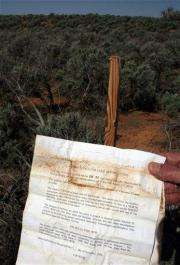Interior halting uranium mining at Grand Canyon

(AP) -- Thousands of mining claims dot 1 million acres near the Grand Canyon, and Interior Secretary Ken Salazar says his department has a responsibility to ensure those resources are developed in a way that protects communities, treasured landscapes and watersheds.
The Interior Department announced Monday that it is barring the filing of new mining claims, including for uranium, on the acreage for two years. Meanwhile, his department will study whether the land should be permanently withdrawn from mining activity.
"Over the next two years, we will gather the best science and input from the public, members of Congress, tribes and stakeholders, and we will thoughtfully evaluate whether these lands should be withdrawn from new mining claims for a longer period of time," Salazar said in a statement.
Environmentalists applauded the decision, while some members of Congress and the mining industry said it would cost jobs and further harm the economy.
The land being set aside covers 633,547 acres under the control of the U.S. Bureau of Land Management and 360,002 acres in Kaibab National Forest.
The protections offered by the Interior Department won't affect uranium mining claims already filed. It's not possible to prevent existing claims from being developed under the General Mining Act of 1872 unless Congress appropriates money for the department to buy them.
The announcement comes ahead of Tuesday's congressional hearing on a bill to set aside more than 1 million acres of federal lands north and south of the canyon. The bill's sponsor, Democratic U.S. Rep. Raul Grijalva of Arizona, and environmental groups had been looking to Salazar for temporary protections at the Grand Canyon while the legislation is pending.
The announcement drew an immediate objection from the mining industry. National Mining Association Vice President Luke Popovich said current laws and regulations are effective for protecting the environment from mining activity.
"So this decision appears on its face to be wholly unjustified and even dumbfounding in view of the near 10 percent jobless rate," Popovich said.
Environmentalists, who contend mining leaves the Grand Canyon vulnerable to environmental damage, praised the decision but said that permanent protection is the goal.
"This decisive action to protect the Grand Canyon sends an important signal that President (Barack) Obama is committed to prioritizing the public interest when it comes to managing America's natural resources," said Jane Danowitz, U.S. public lands program director at the Pew Environment Group.
There are as many as 10,000 existing mining claims on BLM and U.S. Forest Service lands near the Grand Canyon for all types of hard-rock exploration. Some 1,100 uranium mining claims are within five miles of the Grand Canyon National Park.
Most of the claims for uranium are staked in the Arizona Strip, a sparsely populated area immediately north of the Grand Canyon National Park known for its high-grade uranium ore.
Operations in the area ceased some 20 years ago, when the price plummeted for uranium used for nuclear energy, weapons and medicine. With prices now around $55 a pound because of renewed interest in nuclear energy, the industry is eyeing restarting operations.
Toronto-based Denison Mines Corp. is about a year away from mining at a site about 20 miles from the canyon's northern border if it secures an air permit with Arizona state officials. A public hearing is being held this week.
The Interior Department under President George W. Bush was unresponsive to efforts to ban new uranium mining claims. The House Natural Resources Committee invoked a little-used rule to stop any new claims for up to three years, but Interior officials refused to recognize the action and continued to authorize additional mining claims.
A coalition of environmental groups sued, and the U.S. Bureau of Land Management later rescinded Congress' right to withdraw lands from mining and other activities in emergencies.
Since then, environmentalists and Grijalva have been hanging their hopes on Salazar for temporary protections.
Any companion bill to Grijalva's in the Senate is unlikely to come from Arizona's two U.S. senators. Republicans John McCain and Jon Kyl told Grijalva in a letter last month that adequate protections already exist.
On the Net:
http://www.federalregister.gov/OFRUpload/OFRData/2009-17293(underscore)PI.pdf
©2009 The Associated Press. All rights reserved. This material may not be published, broadcast, rewritten or redistributed.
















